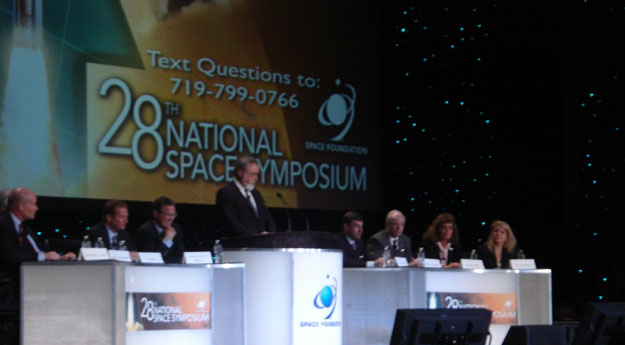Lower Cost at Higher Reliability the Next Frontier for Launch Operators

In the new space race, the sweet spot between affordability and reliability is where commercial launch providers will find the most success.
Several of them gave their corporate pitches Tuesday in a panel delivered to a packed house of military, commercial and government representatives at the National Space Symposium in Colorado Springs.
The speakers represented United Launch Alliance, Safran Group, Pratt & Whitney Rocketdyne, International Launch Services, Arianespace, ATK, Aerojet and SpaceX.
Jim Maser, president of Rocketdyne, expressed frustration with the current perception in Congress and the American public that little money had been invested in commercial launch services.
The company, best known for creating the space shuttle main engine, has put in $750 million in the past seven years, sometimes into programs that ended up being cancelled, he said. He didn’t provide any specific examples.
This means the challenge for Rocketdyne is not so much developing the technology, but keeping up with program priorities.
“The return on investment has not been good,” he said.
United Launch Alliance’s approach is to put the needs of the system first and build up a track record in launching it, said Daniel Collins, its chief operating officer.
According to Space News, ULA has a virtual monopoly on launching security satellites on Evolved Expendable Launch Vehicles, but that may be about to change. As of October, the United States Air Force told ULA that it is going to ask for bids on some of its new missions in the coming years.
While acknowledging the strategy will provide lower launch costs and opportunities for new entrants, Mr. Collins said it is unwise to do competition for competition’s sake.
“We won’t be judged on how widely we employ competition; we’ll be judged on how wisely we employ competition,” he said.
NASA, the USAF and the National Reconnaissance Office inked a memorandum of agreement in October to figure out the necessary criteria for launch vehicle commercial providers, with provisions for new entrants that have an established track record of success.
“The risk-based certification framework allows the agencies to consider both the cost and risk tolerance of the payload and their confidence in the launch vehicle,” an October press release said.
“For payloads with higher risk tolerance, the agencies may consider use of launch vehicles with a higher risk category rating and provide an opportunity for new commercial providers to gain experience launching government payloads.”
This opens to market to launch providers such as SpaceX, which has had success launching NASA payloads (most famously, the Dragon spacecraft) and is starting to break into the Asian market, but has had few defense missions as of yet.
While not speaking specifically to the defense market, SpaceX President Gwynne Shotwell said the company is working on a broad market base to keep their business healthy, and she sees a lot of room in the commercial market to grow given that it is a $5 billion global business.
“What’s key is to provide a reliable price point to attract customers,” she said.
But what will also be key is to navigate that zone between offering a competitive product and making sure that it works well during the launch. Companies seeking that balance, as competition increases, will need to make hard choices about the way they structure their operations – duplicating processes and products where they can – to meet the demand.








